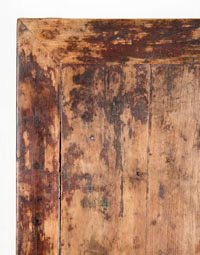 Cypress (Cupressus L.) is categorized along with nanmu in the Song dynasty Yingzao fashi categorizes as a "miscellaneous soft wood" (za ruanmu). Late Ming connoisseurs noted the use of Sichuan cypress as a suitable furniture-making material, and Qing dynasty records from the Yuanmingyuan also indicate that southern cypress was of comparable value to nanmu.
Cypress (Cupressus L.) is categorized along with nanmu in the Song dynasty Yingzao fashi categorizes as a "miscellaneous soft wood" (za ruanmu). Late Ming connoisseurs noted the use of Sichuan cypress as a suitable furniture-making material, and Qing dynasty records from the Yuanmingyuan also indicate that southern cypress was of comparable value to nanmu.
Of several cypress varieties found in modern China, Weeping Cypress (C. funebris) is the most highly regarded for its timber. It is heavily concentrated in Sichuan where it reaches heights of thirty meters and two meters in diameter. Smaller varieties of lesser quality include Bhutan Cypress, with concentrations in Gansu, Fujian Cypress, distributed throughout southern China to the Vietnamese border regions, and Himalayan Cypress (Xizang bai).
The heartwood of Weeping Cypress has a grassy yellowish-brown tonality, and is sometimes slightly streaked with red. With prolonged exposure, the color becomes deeper; the sapwood has paler tonalities. The material has good luster, is somewhat waxy or oily to the touch, and has a pungent fragrance. The grain is generally quite straight and evenly textured. The weight, density (±.58 g/cm3) and hardness are both medium to high. Drying is relatively slow, and requires attention to avoid warpage problems. Afterwards, it is highly resistant to rot and insect damage. The finely textured material is easy to work and polishes to a bright surface.
Extract from:
Evarts, Curtis. C. L. Ma Collection: Traditional Furniture from the Greater Shanxi Region, 1999.
